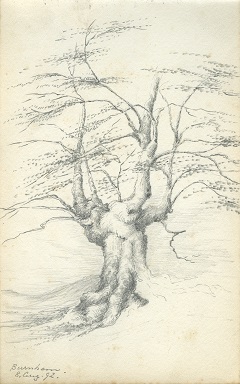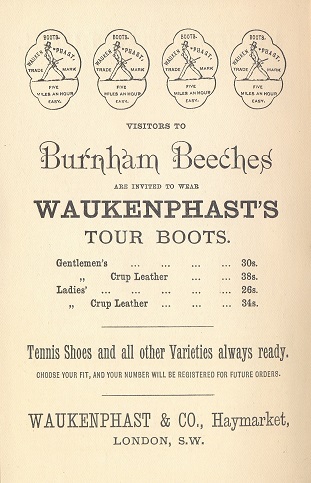 The Sketchbook of Clara Portsmouth
The Sketchbook of Clara Portsmouth
Burnham Beeches, Buckinghamshire
from the Sketchbook of Clara Portsmouth
Burnham
Beeches  ,
noted for its ancient beech and oak pollards,
is now a National Nature Reserve and a Site of Special Scientific Interest.
,
noted for its ancient beech and oak pollards,
is now a National Nature Reserve and a Site of Special Scientific Interest.
 |
|
Burnham 8 August 1892 Collection of the Hampshire Cultural Trust. |
In 1879 the Burnham Beeches woodland, advertised for sale as part of the Dropmore Estate, was purchased by the City of London to protect it as a public open space and wildlife reserve.
In a guidebook for Burnham Beeches, published in 1883, Francis George Heath elucidated his advocacy of environmental stewardship. He made a plea for the protection of the "sylvan beauty and magnificence" of the forests and woodlands that were rapidly disappearing to accommodate the schemes of property developers. His eloquent essay is an interesting contribution to the history of environmentalism.
Francis George Heath was a promoter for environmental activism expressed through art:
"It has been said that the power of the pen is greater than that of the sword. In the cause of our woods it has, at least, been proved that the pen has triumphed over the axe. . . . Never before – we say it with reverent respect for the ancient masters – has art done so much for our English landscapes as in the present day. . . . [How] have pen and pencil succeeded in staying the hands of the wood destroyers? How have they overcome the power of rich and unscrupulous speculators aided by the indifference of the public? We reply – by the force of sentiment, aided by the most perfect representations of Nature which Art can produce".
The 1883 Burnham Beeches guidebook gave directions for travelling to the area. For a visitor from London the start of the excursion was to board a Great Western Railway train from Paddington station to Slough. For other visitors, it would be convenient to take the eastbound train from Reading. On leaving Slough station a walk led to Stoke Poges, then continued to the village of Farnham Royal and finally came to the Beechwoods of Burnham.
To provide easier access for visitors, Burnham Beeches Station was opened in 1899.
Clara Portsmouth would have needed suitable clothing for her sketching tours. Possibly she would have been interested in the walking boots that were featured in an advertisement placed in the 1883 Burnham Beeches guidebook:
 |
Advertisement in Francis George Heath, Burnham Beeches, 1883. "Boots Waukenphast Trade Mark Five miles an hour easy." "Visitors to Burnham Beeches are invited to wear Waukenphast’s Tour Boots." |
References
Francis George Heath (1843–1913), Burnham Beeches, London,
(3rd edition) 1883.Burnham Beeches: Visitor Information
; Visitor Guide
.
Endnote
In his 1883 Burnham Beeches handbook (p. 3) Francis George Heath used the term
"tree lover" to describe a supporter of the preservation of woodlands:
"Only a few years since . . . . the band of tree lovers in this country was terribly small – so small that it could not stay the hands of the destroyers [of forests]. But a brave struggle was made".
This anticipated the term "tree-hugger" that was coined in the later twentieth century.
| Copyright © WhistlerHistory All Rights Reserved. |
Disclaimer | Contact
Revision date: 2025 |